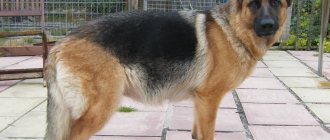Pomeranian Spitz is a dog in heat, pregnancy and childbirth cannot be left without due attention.
Having decided to have a Spitz girl, you need to familiarize yourself with all the nuances of her “women's affairs”. This is necessary to prevent complications, and if problems arise, to know how to solve them.
Features of puberty in Spitz dogs
Puberty and pregnancy in the Spitz are determined by genetics. Some dogs mature earlier, others later. But you can’t set her up with a boy from the very first heat; the baby is not yet physically ready for pregnancy and childbirth.
Breeders recommend breeding girls only from the third heat, even if the first came later than expected.
For example, one Spitz began her first heat at 8 months, and she can be bred at the age of one and a half years. Another girl reached maturity at one year old, and at 1.5 she is not yet ready for pregnancy.
First vaccinations
The first vaccinations are given at approximately 2 months. By this time, the immunity received by the puppy from its mother’s milk is already beginning to weaken, and therefore, if the babies are not vaccinated in time, they will catch literally every infection.
As a rule, puppies, and even adult dogs, are given complex vaccines that protect them from several diseases at once..
Such diseases include leptospirosis, hepatitis, distemper, parainfluenza and enteritis - that is, the most dangerous infections for animals, which, even with early treatment, often end in the death of the pet.
CAREFULLY!
They are especially dangerous for puppies, and therefore it is very important to strictly follow the vaccination schedule suggested by your veterinarian.
Usually, the first vaccine is given at 8-9 weeks . Two weeks after it comes revaccination, which should not be skipped under any circumstances. After this, the dog is vaccinated at 6 and 12 months.
Starting at 12 weeks, the puppy will also need to be vaccinated against rabies..
When does a Pomeranian Spitz first come into heat?
The first heat in Spitz dogs should begin no earlier than 8 months of age and no later than 1 year.
To find out more accurately when your pet will come into heat, you need to ask the breeder at what age her mother came into heat.
Symptoms of estrus and pet behavior characteristics
Dog handlers have noticed that during estrus, Spitz dogs experience changes in behavior and well-being. From this moment on, it is necessary to protect the girl from contact with male dogs of any breed.
The onset of heat in a dog is recognized by the following symptoms:
- The girl becomes disobedient, she begins to ignore the orders of the owner. But at the same time she is more playful, affectionate, and active.
- While walking on the street, male dogs try to come closer to the female Spitz to sniff her.
- The baby begins to urinate more often, and she develops an incredible appetite.
- On walks, the girl will begin to leave more marks so that the boys can find her based on their tracks.
- In some cases, when Spitz dogs begin to heat, they shed.
- The most noticeable sign of estrus is the swelling of the genitals (loops). With light pressure on the loop, a pinkish discharge begins to appear.
Important! If symptoms of estrus appear, walk your Spitz only on a leash, and under no circumstances allow it to frolic. The girl can simply run away when she smells a boy in the distance.
Stages of estrus and their duration
One estrus in a Spitz lasts on average from 18 to 25 days. From the moment the dog matures, the intervals between them are usually 5-8 months.
In rare cases, heat occurs at regular intervals of 9 months, this is completely normal.
Estrus occurs in stages:
- Proestrus is the first stage of estrus, which lasts an average of 12 days. At this time, follicles mature and the amount of mucous membrane in the uterus increases. In the first days of estrus, a girl may show aggression towards the groom chosen for her and will not let him near her.
- Estrus is the moment of maturation of the egg, which begins to move towards the uterus. This is the optimal stage for mating a girl; for Spitz it lasts differently - from 2 to 14 days.
- Metestrus is the stage when a girl’s body produces hormones that will maintain pregnancy in optimal condition. The period lasts up to 70 days, during which the girl does not allow boys near her.
- Anestrus is a state of rest in a Spitz (as well as other breeds) when the eggs stop maturing. Duration up to 5 months.
Caring for a dog during heat
The Spitz's heat lasts almost a month, and this is a difficult period for both the dog and the owner. At this time, the pet needs increased care; she reaches out to the person, not understanding what is happening to her. And the owner’s task is to support the girl.
During estrus, it is recommended to keep your Spitz in the following conditions:
- When a Spitz goes into heat, you need to be especially careful about its health. During this period, the dog can easily catch a cold; it is better to reduce walks on cool days to a minimum or put a litter box at home.
- It is unacceptable to wash a dog during heat. They do not allow it near water bodies.
- If a dog show or competition is planned and the dog is in heat at that particular time, it is recommended to postpone the show.
- Baby diapers or special underwear for dogs in heat will keep the house clean and also protect the girl from getting infections in her reproductive organs;
- You should not allow your Spitz to lie on a cold floor. It is better to make the girl a warm and soft bedding.
Estrus is not a disease, and there is no need for indulgences. If the girl was not allowed on the furniture, then there is no point in pampering her during this period.
Why is there no heat
The first heat in dogs occurs no earlier than 8 months and no later than 15 months of age. If your Spitz has not shown any signs of puberty at one year, then there is no need to worry yet, you can wait a little longer.
Some Spitz girls do not show any signs during their first heat, and the owner may not notice that she has gone through.
Most often, Spitz dogs are not in heat for the following reasons:
- poor living conditions, poor quality or improper nutrition;
- hormonal disorders;
- congenital pathologies in which the functioning or structure of the reproductive organs is impaired;
- problems with the ovaries;
- disorders of the thyroid gland;
- neoplasms on the ovaries or in the pelvic organs (benign and malignant);
- inflammatory disease in the uterus;
- hermaphroditism.
Preparing a Spitz for mating
To get healthy offspring, you should not allow girls who are exhausted, suffer from a lack of vitamins, or are too plump to breed. It is recommended that before deciding to bring the girl together with her groom, you consult a veterinarian and get tested.
If the Spitz was vaccinated less than a month before the intended mating, it is better to postpone the “wedding”.
When the groom has been found and the girl is completely healthy and ready for pregnancy, you need to prepare for mating:
- It is advisable to conduct introductions in the morning, while the dogs are active and not hungry.
- The girl needs to be fed and watered in the evening, but food and water should not be given in the morning, since during mating the dog may vomit from stress.
- Breeders advise breeding Spitz dogs on the groom's territory. If he is brought to a girl, then after mating the dog can run away from his owners in search of the mother of his future offspring.
Signs of pregnancy
Signs of pregnancy in a Spitz are not noticeable in the first days; palpating the girl’s tummy will not yield anything. If after mating the dog becomes pregnant, the estrus ends, the girl becomes more affectionate than usual and less active. This is the first sign that offspring will appear soon.
In the third week of pregnancy, it is already possible to recognize the pregnancy of a Spitz. It happens that the dog begins to tremble, and a transparent discharge appears from the genitals.
Experienced breeders will be able to recognize pregnancy in a miniature dog on the 28th day after mating. At this moment, it will be possible to feel changes in the tummy of the future mother dog.
If you have no experience, it is better to take your pet for an ultrasound: it will show the Spitz’s pregnancy, but will not give an exact answer about the number of babies.
It is possible to more accurately determine how many puppies will be born only after the 45th day of pregnancy, but ultrasound is done solely according to the veterinarian’s indications.
How is pregnancy progressing?
The duration of pregnancy for a Pomeranian is 2 months (8 weeks or 60-63 days).
It is advisable to keep a diary of the course of pregnancy, and it is recommended to start it from the day the estrus begins, during which it was decided to breed.
Changes that occur in a dog’s body during pregnancy:
- At 1-2 weeks, the dog’s behavior and condition remain normal. Fertilization of the egg and its movement to the uterus continues throughout this time.
- At week 3, the placenta forms. At this time, you can take your dog for an ultrasound to diagnose pregnancy. The size of one fetus at 3 weeks is no more than 4.5 mm. The Spitz's mammary glands begin to swell, and the dog may become nervous when biting and scratching them.
- From the 4th week, the active growth of the uterus begins, it can already reach the ribs. For this reason, the dog's belly begins to droop. The babies inside also undergo changes, they grow up to 1.5 cm, and their jaws and skull begin to calcify. At the beginning of the 4th week, the girl suffers from toxicosis and loses her appetite.
- At week 5, puppies develop a bone skeleton and grow noticeably. The Spitz girl becomes even less active, she sleeps more, and her appetite is unstable. Clear discharge appears from the genitals.
- At week 6, babies have all their organs and eyes formed, and they are getting bigger. The girl's uterus takes up more and more space, leaving less space for the stomach. The expectant mother eats often, but in small portions, so food with a maximum calorie content is recommended.
- From 7 weeks, puppies are already covered with fur. The Spitz mother becomes anxious and begins to look for a place to give birth.
- At 8 weeks, the puppies are ready for birth, they are fully formed. At this time, the expectant mother noticeably increases in weight, she is even more anxious, and may refuse to eat.
False
In some cases, an unfertilized bitch may experience symptoms of normal pregnancy. This condition is called false pregnancy.
The cause of this phenomenon may be hormonal imbalance, pathologies and diseases of the genital area, etc. False pregnancy causes a blow to the animal’s psyche, undermines physical health (leads to inflammatory processes in the mammary glands as a result of stagnation of milk).
A dog experiencing a false pregnancy needs the help of a veterinarian who will prescribe the necessary sedatives, psychotropic or even hormonal drugs to stabilize the state of the nervous and other body systems.
The amount of carbohydrate and protein foods in the Spitz's diet should be reduced; dairy products should not be given at all. It is important to ensure control over the dog during this period.
Attention! You should not try to treat the animal yourself - this can only harm it.
Features of caring for a pregnant dog
From the day she starts estrus until the puppies are born, the girl experiences stress. The owner is required to provide the dog with comfort and peace; the health of it and its future offspring depends on this.
If pregnancy occurs after mating, the first few days are considered critical. At this time, the dog is in danger, its life and the condition of the babies are at risk.
It is important to exclude the following unfavorable factors:
- stress;
- changes in nutrition or disruption;
- radiography;
- antibiotic treatment;
- hypothermia;
- overheat.
There is no need to change anything in your diet before the 35th day of pregnancy. It is important that the girl leads her usual lifestyle, without shortening her walks and their duration.
Starting from the 6th week, the Spitz is transferred to three meals a day, leaving the number of portions the same in size. Minerals and vitamins should only be added after consultation with a veterinarian.
From the 30-35th day of pregnancy, they go for walks with the Spitz 2-3 times a day, for a total of at least 2 hours. Active games are not allowed, walks are done at a moderate pace. If you walk less, it will be more difficult for the dog to whelp.
How many puppies are there in the litter?
Most girls of this breed do not have multiple births, so the average litter size for Pomeranians is 2-3 babies.
The size of the litter largely depends on the size of the bitch.
If the girl is small, weighing approximately 2-2.5 kg, then she will most likely give birth to small or medium-sized litters of puppies.
A larger dog can give birth to 4-6 puppies.
Preparing for childbirth at home
If Spitz births take place at home, owners should take courses that will teach them how to accept puppies. But if the dog’s weight is small, it is recommended to perform a cesarean section, which is performed only by an experienced veterinarian in a clinic.
If the doctor has given permission for a home birth, you need to purchase a playpen or box, the size of which should be 2 times larger than the dog. Here she will be with the puppies. A warm bedding is laid on the bottom, an oilcloth on top, then a clean diaper or sheet.
For childbirth, the playpen will be uncomfortable, so prepare a lot of diapers and newspapers in advance, which will protect the floor from discharge and blood.
You cannot install a heater near the playpen; overheating can harm the puppies more than cool weather.
To give birth to a Spitz yourself, you will need the following set of things:
- scissors;
- threads (which are used to tighten the umbilical cord);
- iodine;
- gauze (puppies are accepted into it);
- clean napkins or cloths;
- alcohol (for processing tools and threads).
It is recommended to keep a notebook in which you will need to record all the puppies, their weight and development by day. In order not to confuse the kids, the kids need to be marked with threads of different colors.
Spitz dogs often experience complications during childbirth. Therefore, it is important to agree with the veterinarian about his possible urgent visit.
It is recommended to introduce the girl to him in advance so that during childbirth she does not experience stress from the presence of a stranger.
Signs of imminent labor
Although a Spitz's pregnancy lasts 8 weeks, you need to be fully prepared from the 7th week. About 2 days before whelping, the girl will begin to hide, looking for the calmest and most comfortable place for herself and the puppies. She will begin to lick the nipples, chew off the fur around them, and a viscous discharge will appear from the genitals.
A day before giving birth, the Spitz breathes heavily, moves little, and may even refuse to eat. The dog's belly drops noticeably, and when viewed from above, the animal's back appears thin. The loop swells and becomes soft.
12 hours before birth, the dog’s body temperature drops – it can reach 37 or even 35 degrees.
Types of vaccines
To vaccinate Spitz dogs, monovalent and polyvalent preparations are used. Most veterinary clinic specialists prefer the second type, as it allows you to minimize the time of vaccination and protect the animal from infection with dangerous viruses. But some owners prefer monovalent products, arguing that complex vaccines place an excessive burden on the puppy's immune system and can provoke disease.
List of the most commonly used monovalent vaccines:
- against canine plague - “Vakchum”, “Biovac-D”, “Multikan-1”, “Canivac C”;
- against parvovirus enteritis - “Biovac R”, “Nobivak Parvo-C”, “Primodog”;
- against leptospirosis - “Nobivak Lepto”, “Biovac-L”.
Polyvalent drugs against canine distemper, hepatitis, adenovirosis, coronavirus and parvovirus enteritis, leptospirosis and parainfluenza in various configurations:
- "Kaniwak CH";
- "Multikan-2"
- "Biovac-RA";
- "Triovak";
- Trivirovax;
- "Nobivak DHP";
- "Nobivak DHPPI";
- "Tetravac";
- "Multikan-4";
- "Multikan-6";
- "Hexakanivac";
- Biovac DPAL.
"Multikan-7" in addition to the above diseases prevents infection with ringworm, and "Multikan-8" - rabies.
Delivery at home
The onset of labor in dogs is accompanied by anxiety. The girl is breathing heavily, scratching the bedding. This condition can last from 6 to 12 hours in the case of not the first birth and up to 36 hours in firstborns. It is necessary to monitor the temperature by measuring it rectally - it should remain low.
Then the water will break, pushing will begin, at this moment the temperature rises. This period lasts from 3 to 12 hours, less often – a day. The dog can roll over and sit down as if it wants to go to the toilet.
During a normal birth, the girl will gnaw the umbilical cord herself and eat the afterbirth from the first baby. It is better not to give the rest to her, as there is a risk of developing diarrhea. The girl will lick the puppy, then move her paw to her chest.
If childbirth is difficult and the dog is tired, they help her:
- you need to take clean gauze in your hands;
- pull the puppy gently diagonally towards the exit;
- pierce the bubble in the head area;
- wipe the mucus from the face;
- cut the umbilical cord at a distance of 3 cm from the puppy’s tummy.
Scissors are used dull, treated with alcohol or peroxide. If there is bleeding, the umbilical cord should be tied with threads soaked in alcohol.
Babies cannot be washed; they are wiped with a dry cloth and placed on the dog’s belly; they will find the breast on their own.
If the birth of the second baby is delayed for 2 or more hours after the birth of the first, you should call a veterinarian.
Help will also be needed in the following cases:
- The dog has calmed down, but fruits can still be felt in the stomach. The girl is tired and no longer feels pressure, although not all puppies were born.
- 24 hours after birth, black-green discharge appeared. This is a sign of a puppy dying in the womb or an afterbirth remaining inside the dog.
Afterbirth
It is extremely important to keep a record of all the departed placenta: during the normal course of labor, the number of departed placenta should correspond to the number of puppies born.
It’s not common, but it happens that in the womb two puppies live and develop in the same bubble. If this happens, then the departed placenta should be twice the size of the usual one.
Too long (more than 5 hours) delay of the placenta is a pathology of childbirth.
All this sounds complicated and sometimes even scary, but you shouldn’t be afraid or worry: often the bitch herself, without your help, copes with everything perfectly, because all her generic behavior is dictated by instincts inherent in nature.
Caring for puppies and dogs after birth
Many people believe that if the Spitz’s owner has been caring for him throughout his pregnancy, then after giving birth he can rest. But in the first days after the babies are born, both mother and puppies need even more care.
While a dog is giving birth, it loses a lot of strength and the body is exhausted. But it is not recommended to feed her for 7 hours after birth; only water is given.
If your Spitz requires food, you can give him some cottage cheese or kefir.
The dog will soon want to go to the toilet, it is advisable to install a tray nearby. If she is used to going outside to relieve herself, she should be carried in her arms so that the girl does not waste her strength.
Puppies only need to have their nails filed, which can injure each other or their mother's skin.
Once every 2 days, the room where the Spitz and puppies live is ventilated and wet cleaned. During this time, the dog and children are placed in another place. The litter needs to be changed every day.
After giving birth, a Spitz will fully recover only after 6 months. Previously, it is impossible to breed a girl, even if the period of estrus has begun.
What to feed for the first 3 months?
From about the third week, puppies can already begin to be fed solid food . It is most convenient to start complementary feeding with a scraper.
To do this, take a piece of muscle meat and run the edge of a spoon along its side several times. Small balls, slightly larger than a pea, are made from the scraped meat, and one piece is fed to each of the babies.
Some breeders replace scraped meat with minced meat, but this is incorrect, since minced meat is less easily absorbed by the puppy’s body..
Later, babies begin to be introduced to other foods: cottage cheese mixed with kefir or natural yogurt, as well as porridge added to meat and vegetables.
In addition to beef, small Pomeranians can also be fed rabbit meat, turkey or lamb . But it’s too early to give offal at this age.
Then, it will be possible to add boiled sea fish without bones to the diet, and give boiled chicken yolk twice a week.
IMPORTANT!
If you decide to feed the puppies with ready-made food, then this should be done from the very beginning, after the kids try scraped meat for the first time.
In this case, their diet will consist of branded food no lower than super-premium class, which should be soaked in warm water in the first three months of the puppy’s life.
You can also feed puppies wet commercial food that is suitable for their size and age..
Possible problems
Miniature dog breeds have difficulty with pregnancy and childbirth. And Spitz owners may encounter the following problems:
- The puppies are large in size, and therefore the dog will not be able to give birth on its own, and will have to have a caesarean section.
- Genetic diseases of puppies, manifested in the form of deformities.
- Mastitis after childbirth (this is due to an excess of milk with a small number of offspring).
- Inflammation of the uterus due to the afterbirth remaining in it.
- Postpartum eclampsia.
Giving birth to a dog on your own is a difficult and responsible task. If you are not confident in your abilities, you should seek help from an experienced veterinarian or breeder.
You need to start preparing for the birth of offspring from the moment of the first heat. If the heat goes on quickly or lasts longer than 30 days, you need to undergo a medical examination. The health of the Spitz girl and her babies depends on the attention of the owner.
Possible complications
Your dog may experience the following reactions, which are considered normal after receiving the vaccine:
- lump at the injection site;
- apathy;
- loss of appetite;
- diarrhea;
- hyperthermia.
After 3-4 days, such complications should disappear. Otherwise, you will need to call your veterinarian.
Important! If an animal begins to have convulsions or vomiting a day after vaccination, you should immediately contact a veterinary clinic.











